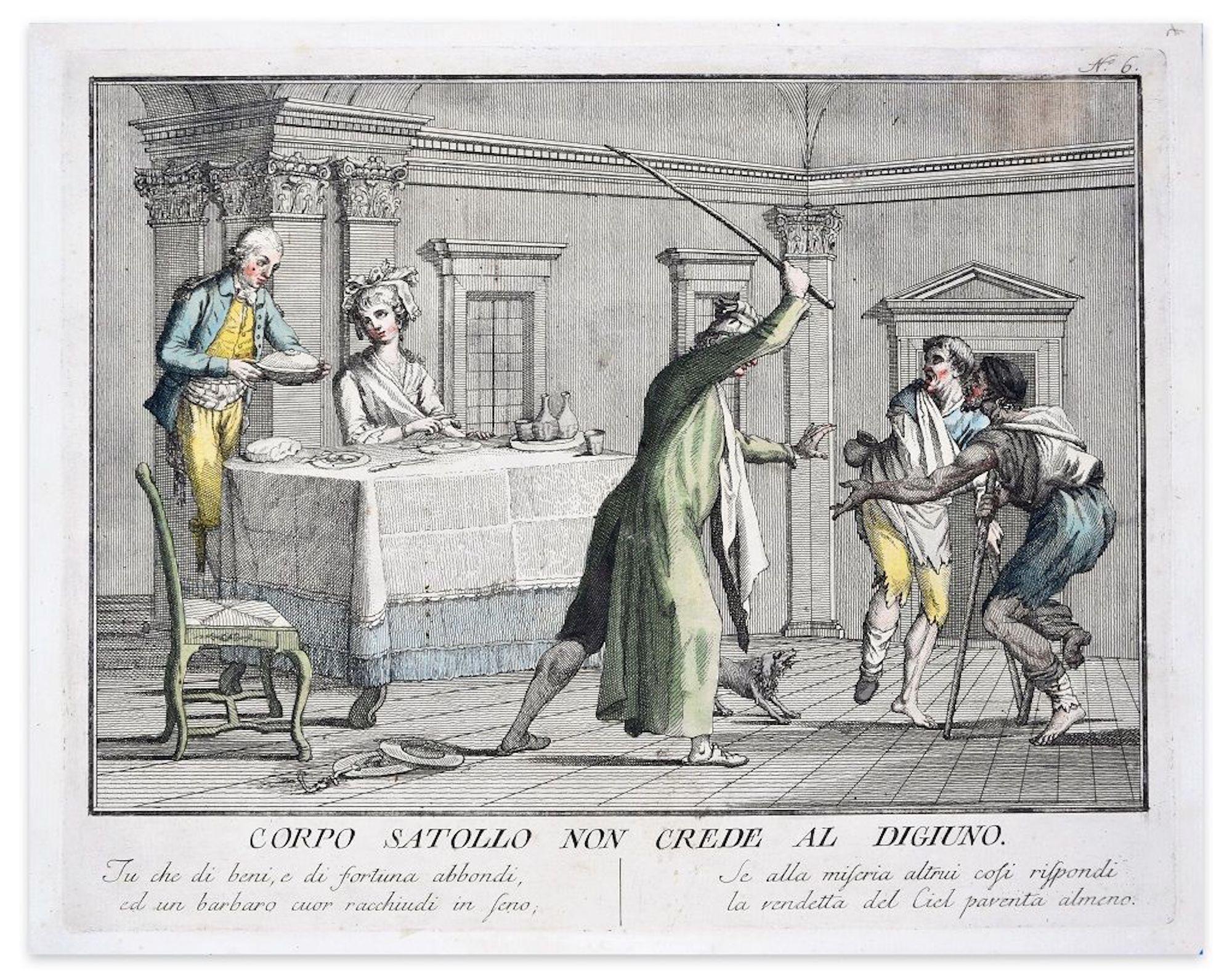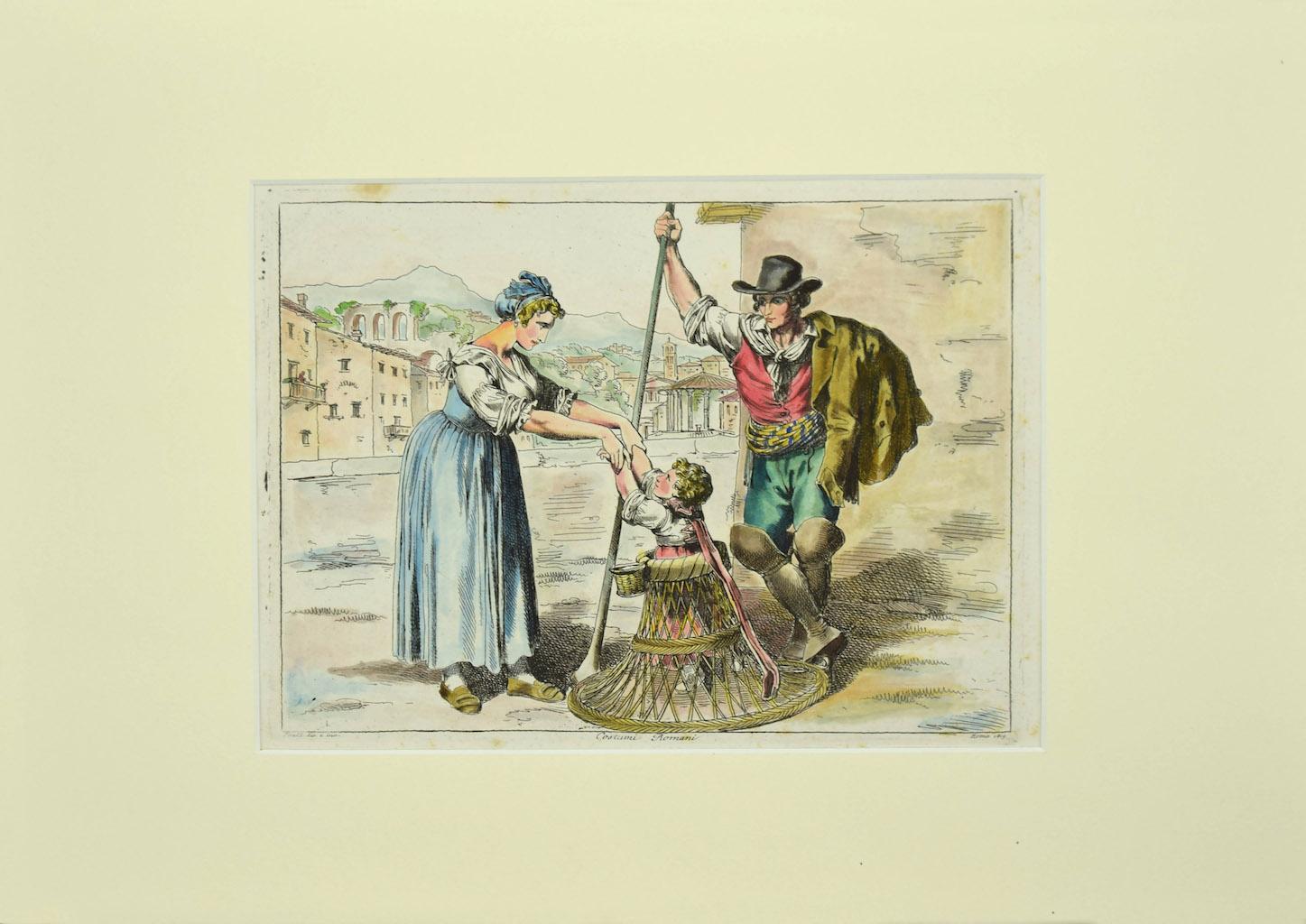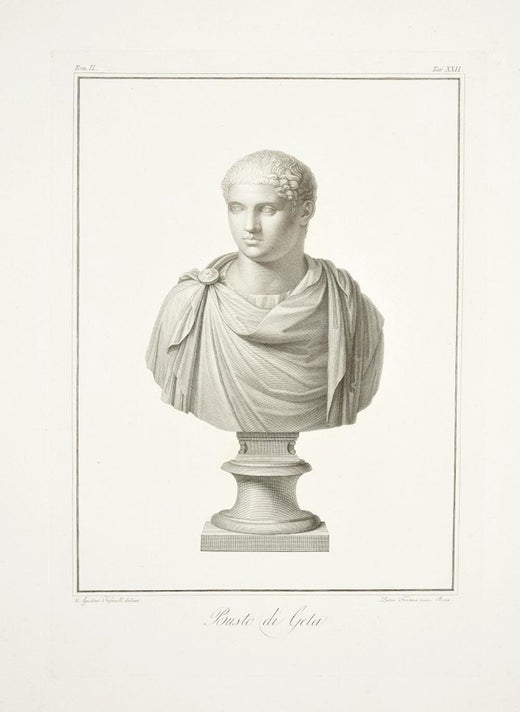Items Similar to Ara con Tripode - Etching by V. Feoli After B. Nocchi - 1821
Want more images or videos?
Request additional images or videos from the seller
1 of 6
Pietro FontanaAra con Tripode - Etching by V. Feoli After B. Nocchi - 18211821
1821
About the Item
Image dimensions: 33.7 x 48.6 cm.
“Ara con tripode” (Ara with tripod) is a beautiful black and white burin and etching on paper, realized by the artist Vincenzo Feoli, after Bernardino Nocchi as the inscriptions on plates on lower margins report “Bernardino Nocchi delineò/ Vincenzo Feoli incise in Roma”.
This original print is numbered on plate in Roman numerals on higher margin: “Tom II. /Tav. XXVIII" and is a plate from the series "Illustrazioni de'Monumenti scelti Borghesiani già esistenti nella Villa sul Pincio (..)date ora per la prima volta in luce dal cav. Gio. Gherardo De Rossi e da Stefano Piale sotto la guida di Vincenzo Feoli", by Ennio Quirino Visconti, published by Stamperia de Romanis in Rome, 1821.
Original Title: Ara con Tripode di quindecemviri, e la corona degli Arvali
Translated Tite: Ara with tripod representing fifteen men, and the Arvali's crown
This old master’s original prints shows a beautiful piece of the Borghese's collection, the commemorative ara with the tripod with the decorations of a crown, the Arvali's Crown. The Arvali was an ancient Roman priestly college twelve members chosen for life among the members of the patrician families, who devoted themselves to the worship of the Goddess Dia, an archaic Roman divinity, later identified with Ceres, and of Marmar or Mavors, later identified with Mars, who protected the earth, the fields and the crops.
In excellent conditions with some light signs of the time, with some sporadic minor stains along the margins, a usual yellowing of the paper at the edges, this beautiful etching has preserved still today his beauty and his fresh impression.
Illustrazioni de' Monumenti scelti Borghesiani
This collection in two volumes is a beautifully detailed catalog of classical sculptures collected by Prince Borghese (1730-1800) in his Villa on the Pincio. Ennio Quirino Visconti (1751 - 1818) wrote the texts that accompany the large branches depicting. To these writings, which were available by the son of the illustrious archaeologist, the publishers added only a few illustrations relating to some minor monument of which copper had already been engraved.
The engraved title-plate are signed by draughtsmen like Agostino Tofanelli, Stefano Tofanelli, Bernardino Nocchi, Domenico de Angelis or Teodoro Matteini, and by engravers Pietro Fontana Veneto, P. Vitali, Pietro Bettelini, Giovanni Folo Veneto, Giovanni Brunetti da Ravenna, Giovanni Ottaviani, Francesco Cecchini, Gio. Batta. Leonetti, Girolamo Carattoni, Domenico Cunego, Luigi Cunego, Alessandro Mochetti, Luigi Pizzi, Angelo Campanella or Giacomo Bossi.
The Volume I shows ancient full-length statues, of the Borghese warrior by Agasias (two plates), Greek gods and heroes and Roman famous historical figures; the last two plates represents antique Egyptian deities. There are plates representing ancient bas-reliefs, sarcophagi, of mythological subjects, the Borghese Vase, portrait busts, a vase on an altar, two statues of Amor; and two modern statues, by Bernini (the Apollo and Daphne, and the David).
«Très bel ouvrage» writes Brunet, «Grand ouvrage, le seul qui mérite, parmi ceux sur la villa Borgese, de figurer dans le chapitre aux Galeries et Collections» Vinet said, looking at this plate.
Vincenzo Feoli (Rome, 1750 - 1831)
Vincenzo Feoli was an Italian engraver and a talented translator of topographic, architectural and archaeological drawings, whose professional capacity seems to have been recognized by his contemporaries. He engraved illustrative plates for the main publishing projects of his era. His first known artworks today date back to the first years of the decade 1790-1799, when he should have been over 40 years old. This led Rossella Leoni to postpone the date of his birth of about ten years.
Bernardino Nocchi (Lucca, 1741 - Rome, 1812)
Bernardino Nocchi moved to Rome in 1769 with his colleague Stefano Tofanelli, entering the school of Niccolò Lapiccola where he developed a baroque style with neoclassical suggestions. Bernardino Nocchi was noticed by Pope Pius VI, who in 1780 entrusted him with the painting of the Sacred Apostolic Palaces and then in 1785 with the Print Room of the Vatican Library. But he also works outside the capital, in Gubbio where in 1797 he realizes the transit of St. Joseph in the Church of San Secondo, in Spoleto, in Lucca and in Catania. Returning to Rome, Nocchi painted some of his best paintings: Prince Camillo Borghese in 1799 , The apotheosis of Saint Prudenziana, Saint Novato and Saint Timothy in 1803 and Pius VII in 1807.
- Creator:Pietro Fontana (1762 - 1837)
- Creation Year:1821
- Dimensions:Height: 17.45 in (44.3 cm)Width: 23.23 in (59 cm)Depth: 0.04 in (1 mm)
- Medium:
- Movement & Style:
- Period:
- Framing:Framing Options Available
- Condition:Insurance may be requested by customers as additional service, contact us for more information.
- Gallery Location:Roma, IT
- Reference Number:
Pietro Fontana
An Italian artist and engraver, Pietro Fontana was active in Rome and specialized in subjects dealing with the Vatican and the Papacy. He started his career as a student of Raffaello Morghen and is best known for his complete series of engravings of the neoclassical sculptures of Canova. He became a member of the Accademia di San Luca.
About the Seller
4.9
Platinum Seller
These expertly vetted sellers are 1stDibs' most experienced sellers and are rated highest by our customers.
1stDibs seller since 2017
6,757 sales on 1stDibs
Typical response time: 2 hours
- ShippingRetrieving quote...Ships From: Grasse, France
- Return PolicyA return for this item may be initiated within 14 days of delivery.
More From This SellerView All
- Liber Veritatis - B/W Etching after Claude Lorrain - 1815By Ludovico CaraccioloLocated in Roma, ITPlate 23 – From Liber Veritatis Aquatint on Copper, Imag. Dim: cm 33x47.5, Dim: cm 21x27, Beautiful Artist’s Proof, representing a shepherd with his herd pastouring at the shore o...Category
1810s Old Masters Figurative Prints
MaterialsEtching, Aquatint
- Corpo Satollo on Crede al Digiuno - Hand Colored Etching by C. Lasinio - 1788Located in Roma, ITCorpo Satollo Non Crede Al Digiuno is an original print realized in 1788 by Carlo Lasinio. Original etching hand-colored. Printed by Niccolò Pagni and Giovanni Bardi, Firenze (Ital...Category
1780s Old Masters Figurative Prints
MaterialsEtching
- Scène de Bistrot - Unknow Artist After Adrian Van Ostade - 18th CenturyLocated in Roma, ITImage dimensions: 15 x 12 cm. Scène de bistrot is a black and white etching with burin interventions on paper realized by an anonymous artist, after the Flemish artist Adrian Van Ostade...Category
Early 18th Century Old Masters Figurative Prints
MaterialsEtching
- Correccion - Etching and Aquatint by Francisco Goya - 1868By Francisco GoyaLocated in Roma, ITCorreccion is an original artwork realized by Francisco Goya and published for the first time in 1799. Etching on wove paper. This artwork belongs to the Third Edition published in...Category
1860s Old Masters Figurative Prints
MaterialsEtching, Aquatint
- Aguarda que te Unten - Etching and Aquatint by Francisco Goya - 1868By Francisco GoyaLocated in Roma, ITAguarda que te unten is an original artwork realized by the artist Francisco Goya and published for the first time in 1799. Original etching on woven paper. The etching belongs to ...Category
1860s Old Masters Figurative Prints
MaterialsEtching, Aquatint
- Roman Costume - Etching by Bartolomeo Pinelli - 1819By Bartolomeo PinelliLocated in Roma, ITRoman Costume is an original hand-colored etching artwork realized by Bartolomeo Pinelli in 1819. Signed by the artist on the plate, dated lower left "Roma, 1819", titled in Italian...Category
1810s Old Masters Landscape Prints
MaterialsEtching
You May Also Like
- Church of St. Costanza, Rome: An 18th Century Piranesi Architectural EtchingBy Giovanni Battista PiranesiLocated in Alamo, CAThis is a framed 18th century Giovanni Battista Piranesi etching entitled: "Veduta interna del Sepocro di Santa Costanza, fabbricat...Category
1770s Old Masters Interior Prints
MaterialsEtching
- Descending from the Cross, by TorchlightBy Rembrandt van RijnLocated in New York, NYRembrandt Harmensz. van Rijn 1606 Leiden – Amsterdam 1669 The Descent from the Cross by Torchlight 1654 etching and drypoint; sheet 213 x 163 mm (8 3/8 x 6 7/16 inches) Bart...Category
17th Century Old Masters Figurative Prints
MaterialsDrypoint, Etching
- One Can't Tell Why - Proof from the Disasters of WarBy Francisco GoyaLocated in New York, NYFrancisco José de Goya y Lucientes (1746 Fuendetodos – Bordeaux 1828), No se puede saber por qué – One can’t tell why ca. 1808–1814, etching, burnished aquatint, drypoint, an...Category
1810s Old Masters Figurative Prints
MaterialsDrypoint, Etching, Aquatint
- Fabricius (Ponte Cestio) Bridge : Framed 18th C. Piranesi Architectural EtchingBy Giovanni Battista PiranesiLocated in Alamo, CAThis framed 18th century etching by Giovanni Battista Piranesi is entitled "Dimostransi nella Tav. presente la Pianta, ed Elevazione del Ponte, oggi detto Quattro Capi egli è antichissimo, e chiamavasi Fabrizio da L. Fabrizio Presid. delle Strade, che lo fabbrico' nel fine della Repubblica. "(The Plan and Elevation of the Bridge, today called Quattro Capi. The architect is very ancient, and was called Fabrizio da L. Fabrizio Presid. delle Strade, who built it at the end of the Republic). This is plate 18 in volume 4 of Piranesi's "Le antichita romane opera di Giambatista Piranesi architetto veneziano" (Roman antiquities by Giambatista Piranesi Venetian architect). It was published in Rome in 1756-1757. This etching depicts the plan and elevation of the bridge now called the Ponte dei Quattoro Capi or Ponte Cestio (Bridge of the Four Heads), which in antiquity was called the Bridge of Fabricius after L. Fabricius, the Superintendant of the Streets who built it at the end of the Republic, around 62 BC. It was also been known in the Middle Ages as ‘Ponte Giudeo’ (Bridge of the Jews). The bridge crossed from the left bank or northeast side of the Tiber River to Tiber Island...Category
1750s Old Masters Landscape Prints
MaterialsEtching
- Crucifixion: 18th Century Etching by Conrad Metz after Daniele da VolterraLocated in Alamo, CA"Crucifixion" is an etching and aquatint, printed in brown ink by Conrad M. Metz after a painting by Daniele da Volterra. It was published in London in 1789 in 'Imitations Of Ancient...Category
Late 18th Century Old Masters Figurative Prints
MaterialsEtching, Aquatint
- Ancient Roman Marble Vase: 18th C. Piranesi Etching Vaso Cinerario di Gran MoleBy Giovanni Battista PiranesiLocated in Alamo, CA"Vaso Cinerario di Gran Mole. Le Teste dei Giovenchi mostrano di reggere it pesante Festone composto di Frutti Fiori Grans ed use. Il tuto Necefsario all Vita Umana. Il Restante degl...Category
1760s Old Masters Figurative Prints
MaterialsEtching
Recently Viewed
View AllMore Ways To Browse
Antique Print Room
Art 1821
After Antique Statue
St Joseph Antique
Antique Italian Altar
Bust After The Antique
Antique Statue Roman
Large Greek Statue
Life On Mars
Roman Warrior
Mars Sculpture
Rome Copper Print
Antique Roman And Greek Sculptures
Ancient Egyptian Prints
Baroque Altar
Antique Tripod Light
Large Bust Statue
Transit Antique






